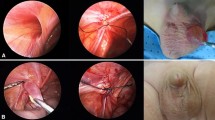Abstract
Purpose
Repair of inguinal hernia and hydrocele are one of the most common operations performed by surgeons. However, the exact biological mechanism responsible for the closure of processus vaginalis (PV) is not completely understood. Transforming growth factor beta 1 (TGF-β1) is a potent fibrogenic agent and probably stimulate fibrosis and disappearing of PV.
Methods
From September 2012 to December 2014, all boys from 1 to 5 years who were referred for surgery of hydrocele were divided into two groups of communicating (HC) or non-communicating hydrocele (HNC). During surgery, the fluid in the sac was aspirated and sent for biochemical evaluation including calcium, phosphorus, total protein, and TGF-β1. Finally, a biopsy of the sac was sent to the pathology. The results obtained were considered statistically significant (P < 0.05).
Results
The patients were categorized into two groups of non-communicating hydrocele, including 43 patients and communicating, including 33. The patients studied were aged 1–5 years (mean 33.6 months). Biochemical tests on hydrocele fluid showed no significant difference in the levels of calcium, phosphorus, total protein, and bilirubin between two groups. However, mean TGF-β1 in NHC was found to be 53.45–114.28 pg/ml in HC group. A statistically significant difference (P = 0.04) was obtained. Furthermore, the study showed higher amounts of muscles in NHC (P < 0.001).
Conclusion
The amount of TGF-β1 was higher in HC fluid than in non-communicating. To investigate the role of cytokine in the closure of PV, further studies will be required.

Similar content being viewed by others
References
Holcomb GW, Murphy JP, Ostlie DJ, Grosfeld JL (2014) Ashcraft’s pediatric surgery. Saunders, Philadelphia
Naji H, Ingolfsson I, Isacson D, Svensson JF (2012) Decision making in the management of hydroceles in infants and children. Eur J Pediatr 171:807–810. doi:10.1007/s00431-011-1628-x
Tanyel FC, Ulusu NN, Tezcan EF, Buyukpamukcu N (2003) Total calcium content of sacs associated with inguinal hernia, hydrocele or undescended testis reflects differences dictate by programmed cell death. Urol Int 70:211–215
Kumar V, Abbas A, Aster J (2015) Robbins and cotran pathologic basis of disease, 9th ed edn. Saunders, Philadelphia, p 105
Sager C, Lopez JC, Duran V, Burek C, Perazzo E (2009) Transforming growth factor-beta1 in congenital ureteropelvic junction obstruction: diagnosis and follow-up. IntBraz J Urol 35:315–323
Hoshino H, Nakajima N, Hihara T, Hayakawa M, Kawamura N (1984) What are the contents of a hydrocele testis? Tokai J ExpClin Med 9:49–51
Madlala TS, Rencken RK, Bornman MS, Reif S, Joubert HF, Van der Merwe CA (1994) Biochemical analysis of tunica vaginalis fluid in patients with or without idiopathic hydroceles. Br J Urol 74:511–514
Dzharbusynov BU, Kastin AV (1990) The pathogenesis of hydrocele. Urol Nefrol 5:58–61
Saha PK, Kanda S, Morimitsu H, Nishimura N, Kanetake H, Saito Y (1990) Transforming growth factor beta-like activity in human hydrocele fluid. Urol Res 18:295–298
Tanyel FC, Dagdeviren A, Muftuoglu S, Gursoy H, Yuruker S, Buyukpamukcu N (1999) Inguinal hernia revisited through comparative evaluation of peritoneum, processus vaginalis, and sacs obtained from children with hernia, hydrocele, and undescended testis. J Pediab Surg 34:552–555
Tanyel FC (2004) Obliteration of processus vaginalis: aberrations in the regulatory mechanism result in an inguinal hernia, hydrocele or undescended testis. Turk J Pediatr 46:18–27
Picarro C, Tatsuo ES, Amaral VF, Gomez RS, Cruzeiro PC, Lanna JC (2009) Morphological comparison of processus vaginalis from boys with undescended testis and hernia sacs from boys with inguinal hernia. Eur J Pediatr Surg 19:145–147
Author information
Authors and Affiliations
Corresponding author
Ethics declarations
Conflict of interest
SA M declares no conflict of interest. L VL declares no conflict of interest. SJ M declares no conflict of interest. SA K declares no conflict of interest. A D declares no conflict of interest.
Statement of human and animal rights
No animal study was conducted. We followed Helsinki declaration and its amendments and followed all standard national and international ethical standards.
Informed consent
Consent from father of patients for publication of this report was taken.
Rights and permissions
About this article
Cite this article
Mousavi, S.A., Larijani, L.V., Mousavi, S.J. et al. The role of transforming growth factor beta 1 in communicating and non-communicating hydrocele. Hernia 20, 589–592 (2016). https://doi.org/10.1007/s10029-016-1492-8
Received:
Accepted:
Published:
Issue Date:
DOI: https://doi.org/10.1007/s10029-016-1492-8




